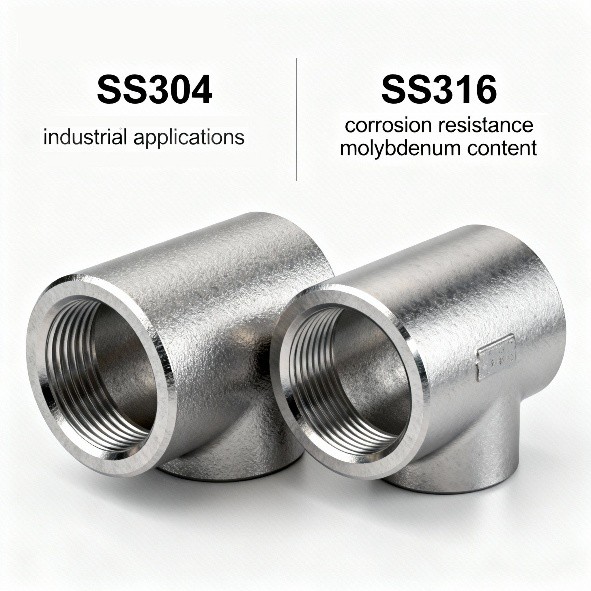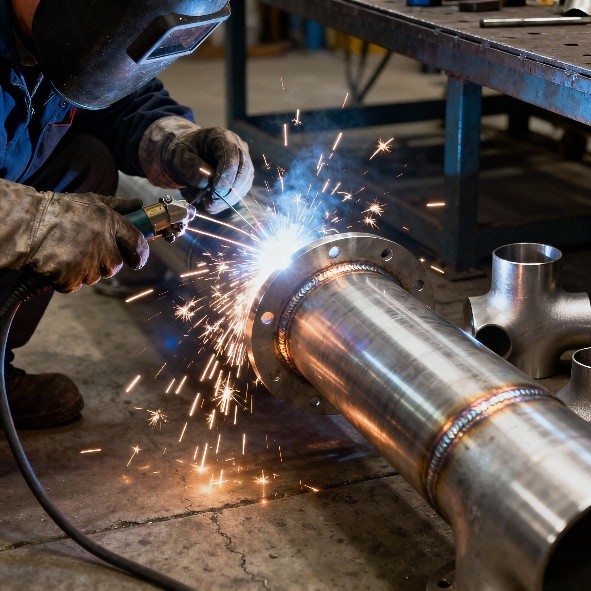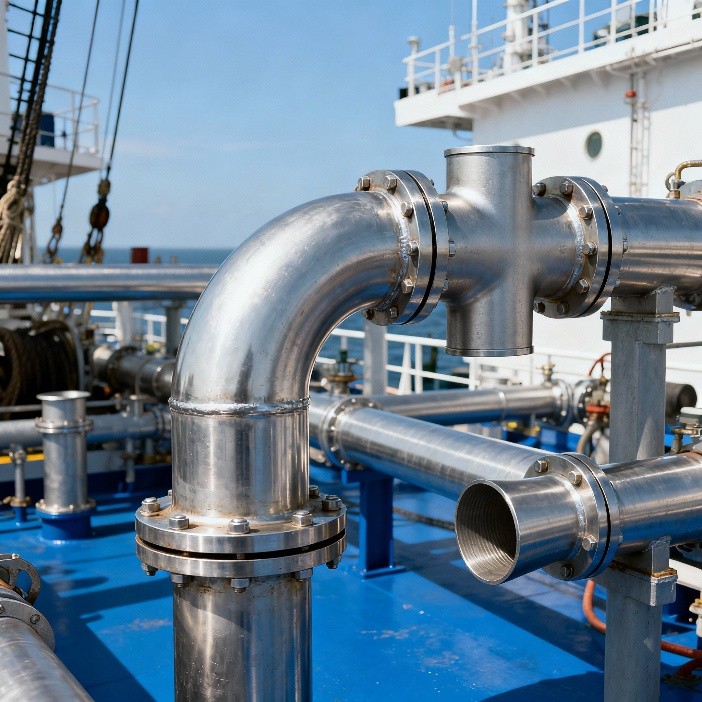Selecting the right stainless steel pipe fittings goes beyond material preference — it’s a critical engineering decision that affects the performance, reliability, and service life of any piping system. Across industries in the USA, Canada, UK, EU, UAE, Middle East, Australia and Africa, procurement engineers, project consultants, and maintenance teams often compare SS304 vs SS316 stainless steel pipe fittings to determine which grade will perform best in their specific operating environment.
Both grades belong to the austenitic family of stainless steels, known for their corrosion resistance and strength. However, subtle differences in chemical composition can significantly influence performance under different process conditions such as high chloride exposure, acidic media, or marine atmospheres. Understanding these differences is essential for ensuring long-term system integrity and compliance with international standards.

What Is 304 Stainless Steel Pipe Fittings?
SS304 stainless steel pipe fittings are the most commonly used type in the stainless steel category, valued for their excellent balance between strength, corrosion resistance, and cost. They are typically chosen for general-purpose piping, food and beverage processing, water supply lines, and architectural applications.
Chemical Composition and Key Properties
• Chromium (Cr): 18–20%
• Nickel (Ni): 8–10.5%
• Carbon (C): ≤0.08%
This composition provides a strong passive oxide film on the surface, making 304 stainless steel resistant to oxidation and mild corrosion. It performs best in indoor or mildly corrosive environments, such as potable water systems or HVAC installations.
Common Manufacturing Standards:
• ASTM A403 WP304 (Buttweld Fittings)
• ASME B16.9 (Dimensions for Buttweld Fittings)
• ASME B16.11 (Forged Fittings)
304 fittings are available in various types, including elbows, tees, reducers, couplings, unions, and caps, manufactured through processes like forging, cold forming, or seamless construction.
In normal service, 304 fittings resist rust effectively. However, when exposed to chloride-rich environments (e.g., coastal regions or chemical plants), they may develop surface rust or pitting corrosion over time. For such conditions, upgrading to SS316 is often a more reliable solution.
What Is 316 Stainless Steel Pipe Fittings?
SS316 stainless steel pipe fittings offer superior corrosion resistance compared to 304, thanks to the addition of molybdenum (2–3%). This single alloying element dramatically improves performance in acidic, chloride, and marine environments.
Chemical Composition and Key Properties
• Chromium (Cr): 16–18%
• Nickel (Ni): 10–14%
• Molybdenum (Mo): 2–3%
• Carbon (C): ≤0.08%
The presence of molybdenum enhances resistance to pitting and crevice corrosion, especially in saline or chemical-rich atmospheres. As a result, SS316 fittings are widely used in chemical plants, offshore platforms, marine pipelines, desalination systems, and pharmaceutical processing lines.
Common Standards:
• ASTM A403 WP316
• ASME B16.9, ASME B16.11
For welded systems or equipment exposed to high-temperature and corrosive fluids, 316 provides superior longevity, reducing maintenance and downtime.

Comparing 304 vs 316 Stainless Steel Pipe Fittings
When selecting between the two grades, engineers must evaluate chemical composition, corrosion resistance, mechanical strength, and cost efficiency.
| Property | SS304 | SS316 |
|---|---|---|
| Chromium | 18–20% | 16–18% |
| Nickel | 8–10.5% | 10–14% |
| Molybdenum | — | 2–3% |
| Carbon | ≤0.08% | ≤0.08% |
1. Corrosion Resistance
The key differentiator is molybdenum. While SS304 offers sufficient protection in clean or mildly corrosive conditions, SS316 resists chloride attack, acidic media, and seawater exposure far more effectively. This makes 316 indispensable in coastal installations, desalination projects, and chemical handling pipelines.
In food processing plants, both 304 and 316 are used — but 316 is typically selected when handling acidic or salty ingredients, ensuring hygiene and preventing surface deterioration.
2. Strength, Temperature, and Durability
Both grades exhibit excellent mechanical strength and can withstand high temperatures — typically up to 870°C (1600°F) in intermittent service. However, 316 provides slightly better tensile and yield strength, particularly in pressurized or high-vibration environments such as refineries, oil & gas facilities, and chemical processing units.
3. Cost and Long-Term Value
From a procurement perspective, SS316 is typically 20–25% more expensive than SS304 due to its molybdenum content and added corrosion resistance. However, this initial cost difference often translates into significant lifecycle savings in harsh environments where 304 would require frequent maintenance or replacement.
In clean water, HVAC, and non-corrosive applications, 304 remains a cost-effective and efficient choice. In contrast, 316 becomes the smarter investment where corrosion failure could disrupt operations or cause contamination.
4. Magnetic Characteristics
Both 304 and 316 stainless steels are non-magnetic in their annealed condition. However, after forming, machining, or welding, they can become slightly magnetic due to microstructural changes — a factor that can be relevant in instrumentation or precision-engineering applications.
Selecting the Right Material Grade Pipe Fittings for Your Industry
Choosing the appropriate stainless steel grade depends on the operating medium, exposure conditions, and performance expectations.
| Industry / Environment | Recommended Grade | Engineering Justification |
|---|---|---|
| Water & Plumbing | 304 | Excellent corrosion resistance in clean water |
| Food & Beverage | 304 / 316 | Use 316 for acidic foods; 304 for general use |
| Chemical Processing | 316 | Handles strong acids, solvents, and chlorides |
| Marine & Offshore | 316 | Superior chloride resistance and durability |
| Pharmaceutical | 316 | Ensures purity and corrosion-free performance |
| Construction & HVAC | 304 | Cost-effective and structurally reliable |
The key difference is molybdenum — its inclusion in 316 significantly boosts corrosion resistance and lifespan in aggressive conditions, while 304 provides a balance of performance and affordability for standard applications.

Certifications and Quality Standards
Before purchasing, it’s essential to verify that fittings conform to recognized international standards. Genuine stainless steel fittings should comply with:
• ASTM A403 / ASME B16.9 – for buttweld fittings
• ASME B16.11 – for forged fittings
• EN 10204 3.1 Material Test Certificate (MTC) – verifying chemical composition and mechanical properties
• ISO 9001 – confirming consistent manufacturing quality
To distinguish between the two grades, the MTC is the most reliable document. It will list the chemical composition, including molybdenum for SS316. Alternatively, field identification can be performed using a molybdenum test kit.
For welded applications, 304 and 316 fittings can be joined together using filler metals such as 308L or 316L, maintaining corrosion resistance at the weld joint.
Technical Summary
• SS304 Pipe Fittings: General-purpose, cost-effective, widely used in non-aggressive environments.
• SS316 Pipe Fittings: Premium corrosion resistance, essential for marine, chemical, and high-purity applications.
• Both Grades: Non-magnetic, high strength, compliant with ASTM/ASME standards, and suitable for a wide range of industrial systems.
Conclusion
Both SS304 and SS316 stainless steel pipe fittings offer outstanding reliability and structural integrity, but the correct choice depends on the operating environment and media handled.
• Choose SS304 when cost efficiency and versatility are priorities — ideal for water systems, HVAC networks, and general industrial pipelines.
• Choose SS316 when corrosion resistance and long-term durability are critical — perfect for chemical, marine, and offshore installations.
Selecting the correct grade from the start ensures system reliability, reduces maintenance costs, and extends service life.
Still deciding between SS304 and SS316 stainless steel pipe fittings?
Let our engineering experts help you choose the right grade for your specific application — whether it’s water treatment, chemical processing, or oil & gas projects.
C-Way Engineering Exports supplies high-quality stainless steel pipe fittings in buttweld, forged, and threaded types, fully compliant with ASTM and DIN standards.
Contact us today to get a technical recommendation or request a quotation for your upcoming project.
FAQ
Q1: What is the difference between 304 and 316 stainless steel pipe fittings?
SS316 contains molybdenum (2–3%), improving resistance to chlorides and acids, while SS304 suits general, non-corrosive applications.
Q2: Which grade is better for marine or chemical plants?
SS316 is superior due to its enhanced corrosion and chloride resistance.
Q3: Can 304 and 316 stainless steel be welded together?
Yes. Use filler metals such as 308L or 316L to maintain corrosion resistance.
Q4: Are 304 and 316 magnetic?
Both are non-magnetic when annealed but may become slightly magnetic after forming or welding.
Q5: How to identify SS304 vs SS316 fittings?
Check the Material Test Certificate — SS316 will list molybdenum content, unlike SS304.







